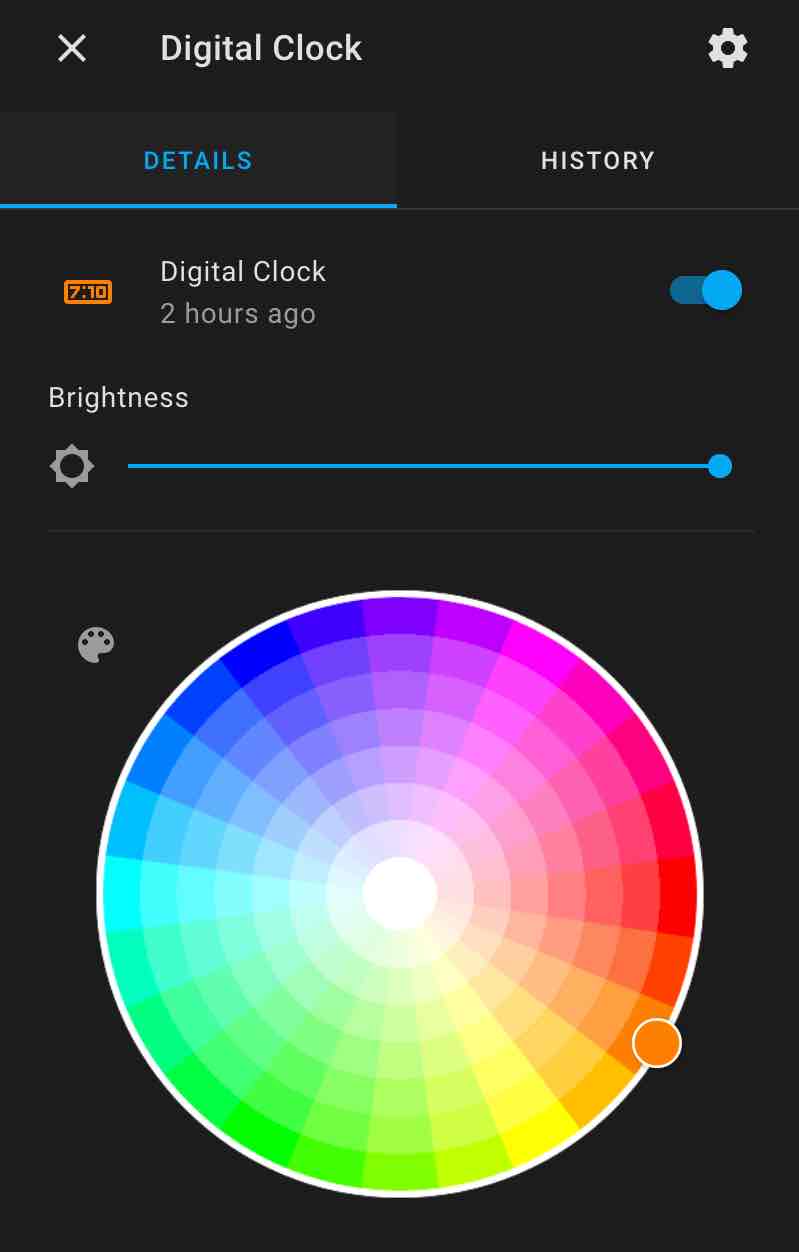This component enables ESPHome to drive an eight-segment display made from FastLED strip with simple configuration.
Comparing to LED matrix and traditional 7-segment display, this display has unique advantages.
- It is not constrained by display size or DPI. You can create a large sharp digital display with minimal number of LEDs. It costs much less than using large eight-segment LED modules.
- The display can be extended easily. Displaying more digits doesn't increase circuit complexity. Most FastLED can be extended with 3 to 4 wires only in a serial way. No additional ICs or ports required.
- Higher brightness can be achieved by using more LEDs.
- Both brightness and colour can be easily controlled.
It's an ESPHome-based general digital display, it can be used for different purposes. For example, it can display date, time, room temperature, noise level etc. Data can also be pulled from Home Assistant.
This project is inspired by the following DIY solutions.
- 7 segment clock by random1101 for ESPHome by Alex18881
- DIY BIG CLOCK - USB POWERED NIST SERVER TIME KEEPING by Ivan Miranda
To build a similar digital display, you need the following components:
- LED * N: Any model listed here is supported, for example
WS2812B. Bigger display may draw higher power, choose higher votage model can reduce current requirement. - A MCU: You need one that ESPHome supported, such as NodeMCU ESP32
- Power supply: Please make sure the power supply can cope with the maximum load of LEDs and still be able to power the MCU.
- A case: Creating a case from scratch takes time and efforts. If you have a 3D printer, you can download and pringt 3D models from Thingiverse or create one yourself. If you don't have 3D printer, you can buy an existing LED digital clock on market (AliExpress), and modify it.
- Wires: connect LEDs, MCU and power supply
- A power connector: to connect power supply to your display
- A step down voltage converter: (optional) If you choose 12V LED, you need to convert power to 5V for MCU.
The display below uses 30 LEDs (WS2812B) and one NodeMCU ESP32, which can be powered directly via USB 5V 2A power adapter. (5V 1A power is not enough for maximum brightness.)
For each digit to display, LED sequence doesn't matter, because you can configure it later, but it's better to keep the sequence consistent across all digits.
Besides 7-segment symbols, you can also add special symbols to the display. Currently period . and colon : are supported.
In this case, for each digit, LEDs are connected in the sequence of BAFEDCG. The green and blue wires are for data, starting from right to left.
A
---
F | | B
-G-
E | | C
---
D
Connect the LED in serial way, starting from RIGHT to LEFT of the display. There should be only 3 to 4 wires, 2 of which connect to power supply. Connect the rest to microcontroller. GND is shared by both power supply and microcontroller.
- Digital Clock supports Internet SNTP time synchronization and daylight time auto-switch.
ref: can either be a branch name (such asmain) or a tag name (such asv0.1.0)
Read more about external components here.
external_components:
- source:
type: git
url: https://github.com/daweizhangau/esphome_addressable_light_digital_display
ref: main
refresh: 0sid is required for display component to reference. Make sure correct chipset, pin, num_leds and rgb_order is set. This light doesn't need to expose to Home Assistant, so internal: true.
light:
- platform: fastled_clockless
internal: true
id: internal_light_state
chipset: WS2812B
pin: GPIO33
num_leds: 90
rgb_order: GRBThe display component is exposed as a light to Home Assistant, but it references the FastLED light.
platform: must beaddressable_light_digital_displayid: ID of the displaylight_id: ID of the display lightname: (Optional) Readable name of the displayicon: (Optional) MDI icon IDaddressable_light_id: FastLED light ID defined aboverestore_mode: (Optional) Recommended to set it toALWAYS_ONotherwise, you need to turn it on in Home Assistant before it can display anything.default_transition_length: (Optional) Recommended to set it to0s.led_map: A string that maps LED to the 7 segments (shown below) and special symbols. From left to right, the map string starts from the first LED to the last LED. Each character in this string map to a LED, space is used as a delimiter.AtoGis used to map a LED to corresponding segment of 7-segment,.and:are used to map corresponding symbols. These characters can be repeated. For example, if 3 LEDs are used to represent Segment B and 3 are used for Segment A, then map string isBBBAAA.reverse: (Optional) Content order. If true, the first led maps to right most character of content string, otherwise, the first LED maps the left most character. True, by default.lambda: C++ code to formulate display content. For more information about print API, please read printable.h. For more information about suported characters, please read ascii_to_raw.h To print time,timecomponent is required.
display:
- platform: addressable_light_digital_display
id: digital_clock
light_id: digital_display_light
name: Digital Clock
addressable_light_id: internal_light_state
icon: "mdi:clock-digital"
restore_mode: ALWAYS_ON
default_transition_length: 0s
led_map: ". CCCDDDEEEFFFAAABBBGGG . CCCDDDEEEFFFAAABBBGGG :: . CCCDDDEEEFFFAAABBBGGG . CCCDDDEEEFFFAAABBBGGG"
reverse: true
update_interval: 500ms
lambda: |-
if (millis() % 1000 < 500)
it.strftime("%H:%M", sntp_time->now());
else
it.strftime("%H %M", sntp_time->now());


